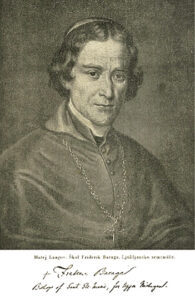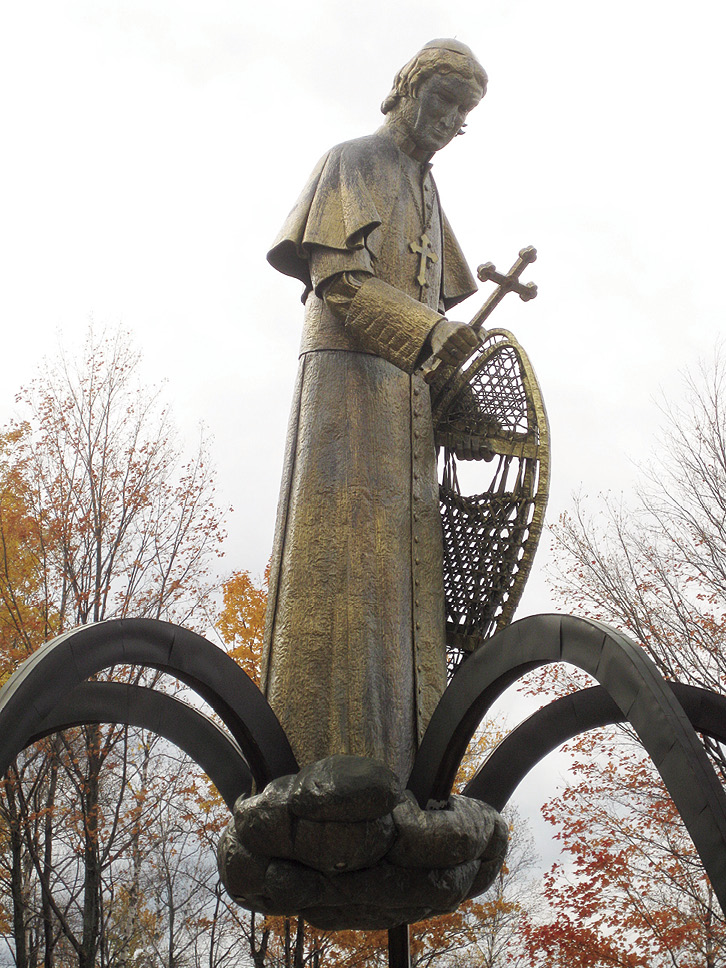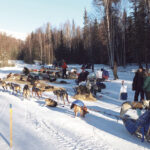In the summer of 1846, a small 18-foot birch bark canoe travelled 40 miles across the unpredictable open waters of Lake Superior from the Apostle Islands, destined for Minnesota’s Grand Portage on the North Shore. On board was voyageur/paddler Louis “Dubois” Gouin and a passenger, the black-robed renowned missionary Father Frederic Baraga.
Nine years later in 1855, German traveller/geographer Johann Kohl, while visiting sites of Baraga’s Lake Superior Ojibwe missions with Canadian voyageur Captain du Roy (the cousin of Dubois), was asked, “Do you know the summer voyage our most reverend friend, your companion, once made in a birch bark canoe right across Lake Superior? Ah, that is a celebrated voyage, which everyone round the lake is acquainted… I will tell you.” The Captain’s account was later published in Kohl’s classic book, Kitchi Gami: Wanderings Around Lake Superior, published in 1860.
According to the Captain, Father Baraga had asked Dubois if he had a boat ready to leave immediately to cross Lake Superior, telling him he had a calling and that his presence on the North Shore was urgently needed. Dubois warned him it was impossible to cross straight across the lake. Rather, the usual canoe route to the North Shore would take eight days, paddling along the coastline so the canoe could be pulled on shore in bad weather. But Baraga, feeling no fear, took his seat in the canoe and was ready to go.
Once underway, the weather was fine at first, just a light wind. Dubois had said they were “floating in a nutshell in the middle of the lake like a loon, without a compass and out of sight of land.” Then, a violent storm with strong winds started. Baraga remained calm, read, and gave Dubois encouragement, telling him, “God would guide them both to land.” Their canoe, according to Dubois, “danced like a feather on water.”
In the morning, shore was sighted—a craggy landscape with “long rows of dark rocks” being battered by strong surf. They could not see an opening for them to land. According to the Captain, his cousin told Baraga, “We are lost, your reverence, for it is impossible for me to keep the canoe balanced in those double and triple breakers.” Baraga’s response was “Paddle on, dear Dubois—straight on. We must get through and a way will offer itself.”

Suddenly, the canoe was safely blown over a sandbar to an inlet at the mouth of a river, near present-day Schroeder. After beaching the canoe, Baraga and Dubois cut down a couple of trees and erected a wooden cross on their landing site overlooking Cross River (named after the cross). Known as Father Baraga’s Cross, it was later replaced by a permanent granite cross monument with a plaque about the harrowing crossing.
Father Baraga was born on June 29, 1797, in the manor house at Mala Vas in today’s Slovenia, the fourth of five children in a well-to-do family. He attended University of Vienna, received his law degree, and then chose a career path to become a priest. The manor house and fortune he had inherited from his parents was given to his sister Antonia, as he broke off his marriage engagement. On September 21, 1823, he was ordained a Roman Catholic priest.
Seven years later (1830), Baraga arrived in New York City to work as a missionary around Lake Superior and Lake Michigan, making frequent trips to Duluth and Grand Portage, as well as Fort William (now part of Thunder Bay) and Bruce Mines.
In 1843, Baraga founded the mission at L’Anse, Michigan and lived there until his death on January 19, 1868. It was here that he was nicknamed the “Snowshoe Priest” for his far-flung travels by snowshoe to his missions in winter. One winter, he snowshoed about 700 miles (return trip) to Duluth, while another time he snowshoed 57 miles in a snowstorm. Overall, during his ministry to Native populations and early settlers in the Upper Great Lakes, he covered thousands of miles by foot, canoe, horseback, and snowshoe.
A prolific writer who was fluent in eight languages, he wrote many books, including 29 Native American books like a large Ojibwe dictionary, plus prayer books in the Otawa and Ojibwe dialects.
In his book, author Kohl wrote about Baraga: “There was hardly a locality of the lake which is not connected with the history of his life, either because he built a chapel there, or wrote a pious book, or founded an Indian parish, or else underwent danger and adventures there, in which he felt that Heaven was protecting him.”
In 1853, Baraga was elevated to Bishop, and became the first Bishop of today’s Diocese of Marquette. And 101 years later in 1952, the path to his sainthood was officially opened for cause and in 1973, the official process to sainthood started for the Venerable Bishop Frederic Baraga, and continues today.
Perhaps the formal process of canonization for the black-robed missionary Father Baraga—who took that dangerous journey 178 years ago across Lake Superior—will someday declare him a saint.




